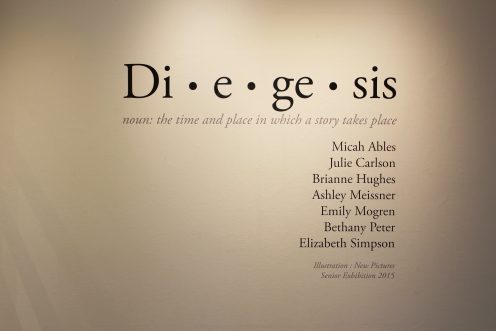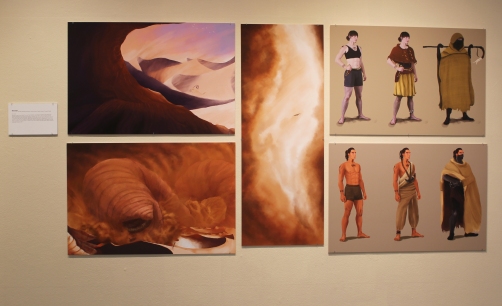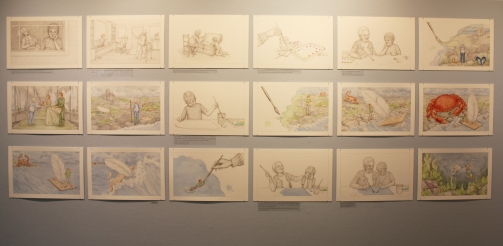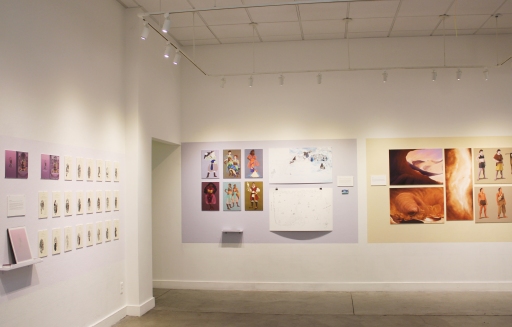Articulating judgment onto a show of student work is an exceedingly difficult task. Their skills are apparent and visibly displayed – as this group of artists have spent their years being taught technicalities and the in’s and out’s of creating work. Aside from this fact, creativity within this bunch is still budding and it is safe to say that these gifted individuals display that innovation is not quite yet grasped. The show ‘diegesis: noun: the time and place in which a story takes place’ features seven senior art students: Micah Ables, Julie Carlson, Brianne Hughes, Ashley Meissner, Emily Mogren, Bethenny Peter, and Elizabeth Simpson. All seven of these bright-eyed artists have created displays of two-dimensional storyboards depicting various worlds of whimsy. Collectively standing, each piece is placed in a world of it’s own, individually, each as fantastical as the next. The artists, although exhibiting clear stylistic differences, gravitate toward worlds full of emotional sentimentality – an idea not uncommon to the 20-something aspiring artist.
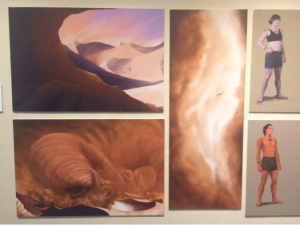
With these pretences aside, Ables’ efforts standout amongst the rest, exhibiting more originality than his peers. His inspirations are clear; I am sensing a nod to the 1979 dystopian film Mad Max, but his work still seems to be relevant today in the midst of the societal obsession with apocalyptic futures. I will comment that his work does not give a complete feel of the story that he has begun to outline, which is understandable because his reference, the novel Dune by Frank Herbert, is a multi faceted commentary on politics, ecology, technology, and human emotion. However, because of his boiled down interpretation of setting and characters there seems to be a disconnect between the piece and its’ viewers.
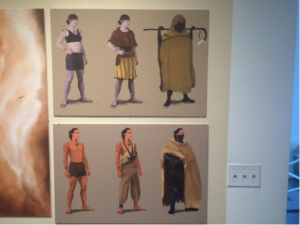
Digressing from the shortcomings of Ables’ work, I do commend him on the character illustrations that he has created – seeing as they are wholly unique and strike viewers with a sense that there is a deeper story to be told by each of them separately – one is left with a desire to learn more rather than dismissing them as merely illustration.
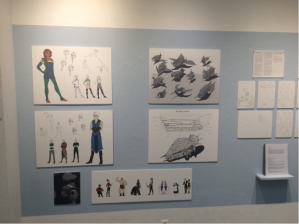
Simpson, like Ables, pulls from a variety of external sources in her storyboard creation. The characters, although interesting, seem to have stepped out of the world of Atlantis and Treasure Planet, both Disney creations are even stories about finding one’s place in the world(s). Both are also stories of unlikely misfits joining together to obtain their goals, which is clearly outlined in Simpson’s artist statement. Aside from this oversight, the illustrations that she displays are visual appealing and draw the viewer to study each mechanical figure separately, for each are deeply intricate and highly detailed.
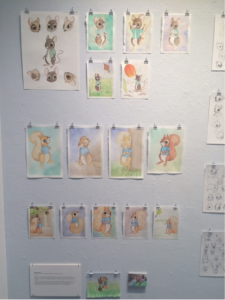
An argument could be made that the artists mostly risk being too influenced by Disney, often making nods toward fairytale-esque ideas of freedom and opportunity, but I still find myself drawn toward the works of Bethany Peter. Despite my natural inclination to dismiss nostalgia, the more one observes the wide-eyed animals within Peter’s pieces the more likely one is to be transported to their days of finger paints and mid-afternoon naps. The flare Peter has for positivity and cheerful design is seemingly overwhelming and, at first glance, may be interpreted as satire on children’s cartoons to the hardened heart.
– Landry Desmond

